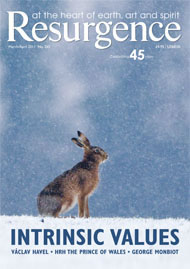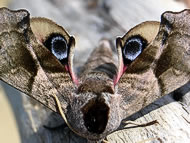‘After the death of Montezuma at the hands of the Conquistadors, his priests sacrificed butterflies in fires.’ The insects thus offered up (known to modern biologists as three-tailed tiger swallow-tails) are known to have been a symbol of the Aztec goddess of love, flowers and war. This gesture of a civilisation in terminal crisis is described, on the final page, in much the same deliberate idiom as has prevailed throughout, and is all the more effective for that.
Philip Howse has earned his living as a professional field biologist and his experience strongly colours this book. Messages from Psyche deplores a scientific culture operating ever further from nature and which ‘accepts only evidence that is verifiable statistically’. In support of his own approach, he cites early objections to The Origin of Species, accusing Darwin of being too speculative.
His central argument is that to understand the patterns on butterfly wings, we need to understand the reflexes of the predator species they have evolved to deter. Taking a leaf out of Temple Grandin’s Animals in Translation, he argues that animals, like some autistic people, don’t have Gestalt perception: ‘When a bird looks at a moth… it sees the details first – the eye-spots, the waspish stripes or whatever happens to be there.’ Each feature will be seen ‘in isolation from the rest’ and it is these details that determine whether the moth is treated as food or danger. The bird has no ‘mental image of a generalised moth’ as humans do. It is our ‘mental image’ which prevents us from seeing the moth as a bird might and, therefore, from understanding why its wing-markings might have evolved the way they have.
Some of this difference in the way we see is just down to quality of eye-sight. ‘A sparrow has about twice as many light-sensitive cells in the retina as a human and hawks have five times as many.’ Birds can also see in the ultraviolet spectrum as we cannot. But this is about speed too: the decision about whether a moth is ‘treated as food or danger’ will generally, in the nature of things, be taken at great speed. The argument here becomes one not just about ‘seeing’, but about perceiving.
In insects, amphibians, reptiles and birds, the recognisable elements in any given image are detected by nerves behind the light-sensitive cells themselves, rather than being relayed to the visual cortex for processing, as in mammals. In humans there are in fact two separate nervous pathways to the part of the brain which controls fear responses, the amygdale. The slower path goes via the cerebral hemispheres, the faster one travels there (in 12 mili-seconds!) directly from the senses via the thalamus. This is how we react ‘without thinking’ to that snake on the cliff-path, say, and this latter automatic response is obviously the important one for survival.
In the fraction of a second available to it, the butterfly or moth needs to ‘sabotage the perceptual process’, to confuse the image analysis of the would-be predator. This may take the form of a ‘startle-display’, a ‘sudden change of form and aspect’, as in wings that open to reveal large staring eyes or a bird’s head. It may be more in the manner of the ‘dazzle-painting’, with which battleships were disguised during the First World War, tricking submarine commanders as to their size and / or direction of travel.
It might be objected that the shapes Howse has found on butterfly wings are only approximately similar to other creatures. But it isn’t only that the ‘key-identifiers’ don’t need to be too precise: their very imprecision may in itself confer an advantage. ‘What does this eye belong to?’ the predator wonders, in effect. ‘What sort of creature have I encountered?’ Startled by the image fragments which have suddenly sprung up, the predator hesitates and that is, potentially, the moment of escape. The spidery legs, the hornet-or snake-heads ‘do not need to be arranged… as a coordinated whole to be effective.’ Foraging through the trees, an insectivore might come upon the moth or butterfly from any angle, its wings in any position: their design has evolved accordingly, its different elements facing different ways.
Howse’s range of reference is wide and enjoyably so, from Minoan bee-shaped ear-rings to the moths concealed in movie-posters. In the way they create arresting moments, for example, butterfly wing-patterns are a form of ‘natural surrealism’: cue exploration of the way surreal art was later exploited by cigarette advertisers. It is pleasure, rather than fear, which the latter seek to evoke, of course, but their manner of playing on the split-second reflexes of a passer-by is, he argues, comparable. ‘This book is not so much about the natural history of butterflies and moths…’ Howse writes, ‘it is about the way we perceive visual images compared with the way in which animals see things.’
That the word for soul and the word for butterfly was the same in Greek suits Howse just fine and this book, as my opening quote perhaps suggests, is full of curious information and ideas. Invoking Jung, he speaks of symbols which ‘assist the unconscious to find expression in art’, of ‘deep-rooted configurations in the human psyche.’ Taking the death’s head moth as his example, Howse demonstrates how variable its significance for humans has been in different times and places. How, then, he asks ‘can we presume to know how animals see it?’ It was not, of course, as a response to human beings that the patterns on that moth evolved. Quite different ‘configurations’, he argues, lurk in the ‘psyche’ of those (non-human) creatures to which the patterns are actually addressed.
In our own symbolic structures, in other words, he finds a clue to the way other creatures might see the world; and thereby, surely, suggests a way we might learn both to understand and to share it better. This is a beautiful and intelligent work.








